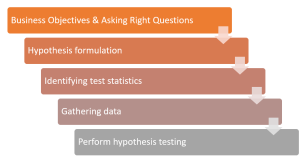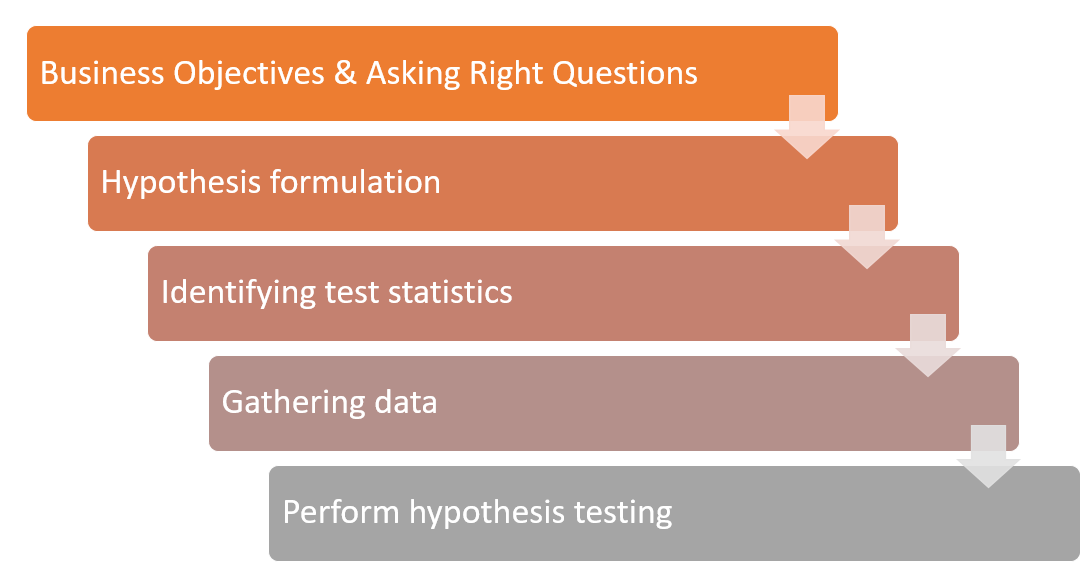
Are you a product manager or data scientist looking for ways to identify and use most appropriate hypothesis testing for understanding business problems and creating solutions for data-driven decision making? Hypothesis testing is a powerful statistical technique that can help you understand problems during exploratory data analysis (EDA) and identify most appropriate hypotheses / analytical solution. In this blog, we will discuss hypothesis testing with examples from business. We’ll also give you tips on how to use it effectively in your own problem-solving journey. With this knowledge, you’ll be able to confidently create hypotheses, run experiments, and analyze the results to derive meaningful conclusions. So let’s get started!
Before going any further, you may want to check out my detailed blog on hypothesis testing – Hypothesis testing steps & examples.
The picture below represents the key steps you can take to identify appropriate hypothesis tests related to your business problem you are trying to solve.

Business Objective / Problem Analysis to Asking Key Questions
Here are the steps which you can use to come up with hypothesis tests related to your business problems. You can then use data to perform hypothesis tests and arrive at different conclusions or inferences.
- Setting / Identifying business objective: First & foremost, you need to have a business objective which you want to achieve. For example, achieve an increase of 10% revenue in the year ahead.
- Identifying key business divisions / units and products & services: Second step is to identify key departments / divisions and related products & services which can help achieve the business objective. For current example, sales can be increased by increase in sales of products and services. For service based companies, it can be increase in sales of existing services and one or more new services. For products based companies, it could be increase in sales of different products.
- Identify key personas / stakeholders: For each business division / department, identify key personas or stakeholders who could be accountable for contributing to achievement of business objective. For current example, it could personas / stakeholders who would own the increase in sales of products and / or services.
- Asking questions: Personas / stakeholders related to each products and / or services would then have to start asking the questions. For current example, lets take a product based SAAS company which would want to increase the sales of different products including product A, B and C. Here are some of the questions that can be asked:
- Are the sales of product A, B and C different?
- Are the sales of product A, B and C similar across all the regions, countries, states, etc.?
- Are there differences between products and competitors’ products vis-a-vis sales?
- Are there any differences between customer queries / complaints across different products (A, B, C)?
- Are there any differences between product usage patterns across different products, and for each product?
- Are there differences between marketing initiatives run for different products?
- Are there differences between teams working on different products?
Hypothesis formulation
Once the questions have been asked / raised, you can create hypotheses from these questions in order to arrive at the answers based on data analysis and create strategy / action plan. Lets take a look at one of the question and how you can formulate hypothesis and perform hypothesis testing. We will also talk about data and analytics aspects.
In order to create strategy around increasing sales revenue, it is very important to understand how has been the sales of different products in past and whether the sales have been different for us to dig deeper into the reasons and create some action plan?
The status quo becomes null hypothesis ([latex]H_0[/latex]. In our current analysis, the status quo is that there is no difference between the sales revenue of different products and that each product is doing equally good and selling well with the customers.
[latex]H_0[/latex]: There is no difference between sales revenue of different products.
The new knowledge for which the null hypothesis can be thrown away can be called as alternate hypothesis, [latex]H_a[/latex]. In current example, the new knowledge or alternate hypothesis is that there is a significant difference between the sales revenue of different products.
[latex]H_a[/latex]: There is a significant difference between sales revenue of different products.
Identifying Test Statistics for Hypothesis Testing
Once the hypothesis has been formulated, the next step is to identify the test statistics which can be used to perform the hypothesis test.
We can perform one-way Anova test to check whether there is a difference between sales based on the product. One-way ANOVA test requires calculation of F-statistics. The factor is product and levels are product A, B and C. Read my blog post on one-way ANOVA test to learn about different aspect of this test. One-Way ANOVA Test: Concepts, Formula & Examples
Apart from Hypothesis test and statistics, one can also set the level of significance based on which one can reject the null hypothesis or otherwise. Generally, it is chosen as 0.05.
Gather Data
Once the hypothesis test and statistics gets chosen, next step is to gather data. You can identify the system which holds the sales data and then gather the data from that system for last 1 year.
Perform Hypothesis Testing
Once the data is gathered, you can use Excel tool or any other statistical packages in Python / R and perform hypothesis testing by doing the following:
- Calculating the value of test statistics
- Calculate P-value
- Comparing the P-value with level of significance
- Reject the null hypothesis or otherwise
Conclusion
In conclusion, hypothesis testing is an essential tool for businesses to make data-driven decisions. It involves identifying a problem or question, formulating a hypothesis, identifying the appropriate test statistics, gathering data, and performing hypothesis testing. By following these steps, businesses can gain valuable insights into their operations, identify areas of improvement, and make informed decisions. It is important to note that hypothesis testing is not a one-time process but rather a continuous effort that businesses must undertake to stay ahead of the competition. Examples of hypothesis testing in business can range from identifying the effectiveness of a new marketing campaign to determining the impact of changes in pricing strategies. By analyzing data and performing hypothesis testing, businesses can determine the significance of these changes and make informed decisions that will improve their bottom line.
- Questions to Ask When Thinking Like a Product Leader - July 3, 2025
- Three Approaches to Creating AI Agents: Code Examples - June 27, 2025
- What is Embodied AI? Explained with Examples - May 11, 2025
I found it very helpful. However the differences are not too understandable for me